Leader of the pac
Page 30
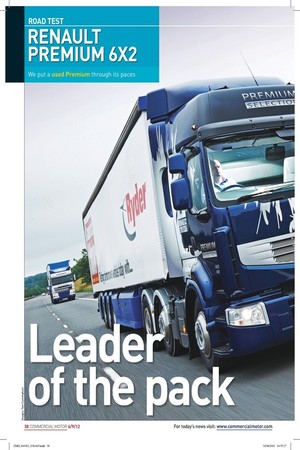
Page 31
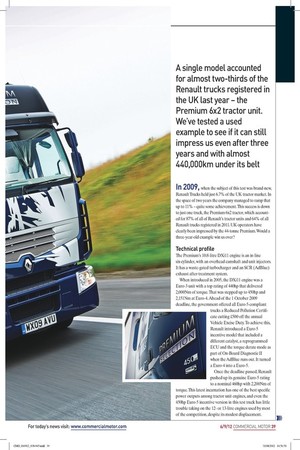
Page 32
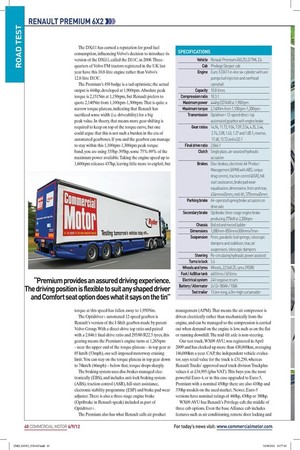
Page 35
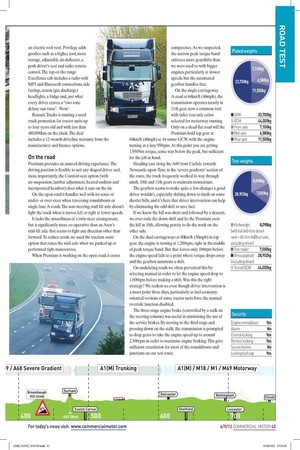
Page 36

Page 33
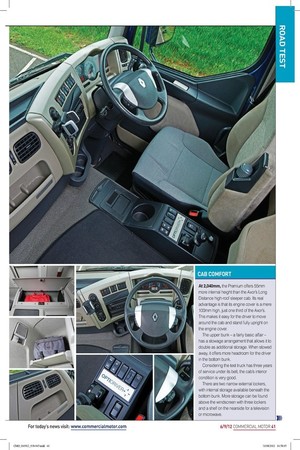
Page 37
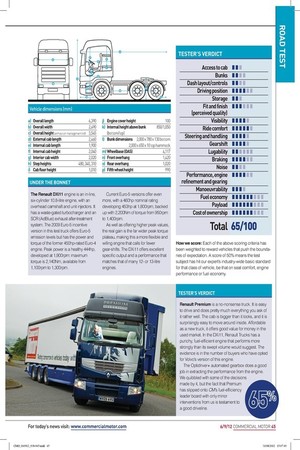
If you've noticed an error in this article please click here to report it so we can fix it.
A single model accounted for almost two-thirds of the Renault trucks registered in the UK last year – the Premium 6x2 tractor unit. We’ve tested a used example to see if it can still impress us even after three years and with almost 440,000km under its belt
In 2009, when the subject of this test was brand-new, Renault Trucks held just 6.7% of the UK tractor market. In the space of two years the company managed to ramp that up to 11% – quite some achievement. This success is down to just one truck, the Premium 6x2 tractor, which accounted for 87% of all of Renault’s tractor units and 64% of all Renault trucks registered in 2011. UK operators have clearly been impressed by the 44-tonne Premium. Would a three-year-old example win us over?
Technical profile
The Premium’s 10.8-litre DXi11 engine is an in-line six-cylinder, with an overhead camshaft and unit injectors. It has a waste-gated turbocharger and an SCR (AdBlue) exhaust after-treatment system.
When introduced in 2005, the DXi11 engine was a Euro-3 unit with a top rating of 440hp that delivered 2,000Nm of torque. That was stepped up to 450hp and 2,151Nm at Euro-4. Ahead of the 1 October 2009 deadline, the government offered all Euro-5-compliant trucks a Reduced Pollution Certiicate cutting £500 off the annual Vehicle Excise Duty. To achieve this, Renault introduced a Euro-5 incentive model that included a different catalyst, a reprogrammed ECU and the torque derate mode as part of On-Board Diagnostic II when the AdBlue runs out. It turned a Euro-4 into a Euro-5.
Once the deadline passed, Renault pushed up its genuine Euro-5 rating to a nominal 460hp with 2,200Nm of torque. This latest incarnation has one of the best speciic power outputs among tractor unit engines, and even the 450hp Euro-5 incentive version in this test truck has little trouble taking on the 12or 13-litre engines used by most of the competition, despite its modest displacement. The DXi11 has earned a reputation for good fuel consumption, inluencing Volvo’s decision to introduce its version of the DXi11, called the D11C, in 2008. Threequarters of Volvo FM tractors registered in the UK last year have this 10.8-litre engine rather than Volvo’s 12.8-litre D13C.
The Premium’s 450 badge is a tad optimistic; the actual output is 444hp, developed at 1,900rpm. Absolute peak torque is 2,151Nm at 1,150rpm, but Renault prefers to quote 2,140Nm from 1,100rpm-1,300rpm. That is quite a narrow torque plateau, indicating that Renault has sacriiced some width (i.e. driveability) for a big peak value. In theory, that means more gear-shifting is required to keep on top of the torque curve, but one could argue that this is not such a burden in the era of automated gearboxes. If you and the gearbox can manage to stay within this 1,100rpm-1,300rpm peak torque band, you are using 335hp-395hp, some 75%-89% of the maximum power available. Taking the engine speed up to 1,600rpm releases 437hp, leaving little more to exploit, but torque at this speed has fallen away to 1,950Nm.
The Optidriver+ automated 12-speed gearbox is Renault’s version of the I-Shift gearbox made by parent Volvo Group. With a direct-drive top ratio and paired with a 2.846:1 inal-drive ratio and 295/80 R22.5 tyres, this gearing means the Premium’s engine turns at 1,265rpm – near the upper end of the torque plateau – in top gear at 85 km/h (53mph), our self-imposed motorway cruising limit. You can stay on the torque plateau in top gear down to 74km/h (46mph) – below that, torque drops sharply.
The braking system uses disc-brakes managed electronically (EBS), and includes anti-lock braking system (ABS), traction control (ASR), hill-start assistance, electronic stability programme (ESP) and brake pad wear adjuster. There is also a three-stage engine brake (Optibrake in Renault-speak) included as part of Optidriver+.
The Premium also has what Renault calls air product management (APM). That means the air compressor is driven electrically rather than mechanically from the engine, and can be managed so the compression is carried out when demand on the engine is low, such as on the lat or running downhill. The mid-lift axle is non-steering.
Our test truck, WX09 AVU, was registered in April 2009 and has clocked up more than 438,000km, averaging 146,000km a year. CAP, the independent vehicle evaluator, says retail value for the truck is £31,250, whereas Renault Trucks’ approved used truck division Truckplus values it at £34,995 (plus VAT). This buys you the most powerful Euro-4, or in this case upgraded to Euro-5, Premium with a nominal 450hp: there are also 410hp and 370hp models on the used market. Newer, Euro-5 versions have nominal ratings of 460hp, 430hp or 380hp.
WX09 AVU has Renault’s Privilege cab, the middle of three cab options. Even the base Alliance cab includes features such as air conditioning, remote door locking and an electric roof vent. Privilege adds goodies such as a higher roof, more storage, adjustable air-delector, a posh driver’s seat and radio remote control. The top-of-the-range Excellence cab includes a radio with MP3 and Bluetooth connections, side fairings, xenon (gas discharge) headlights, a fridge and, just what every driver craves, a “two-tone deluxe sun visor”. Wow!
Renault Trucks is running a used truck promotion for tractor units up to four years old and with less than 480,000km on the clock. The deal includes a 12–month driveline warranty from the manufacturer and inance options.
On the road
Premium provides an assured driving experience. The driving position is lexible to suit any shaped driver and, more importantly, the Comfort seat option (with air-suspension, lumbar adjustment, heated cushion and incorporated headrest) does what it says on the tin.
On the open road it handles well with no sense of underor over-steer when traversing roundabouts or single-lane A-roads. The non-steering, mid-lift axle doesn’t ight the truck when it moves left or right at lower speeds.
It lacks the smoothness of a twin-steer arrangement, but is signiicantly more co-operative than an Axor’s mid-lift axle that seems to ight any direction other than forward. To reduce scrub, we used the traction assist option that raises the mid-axle when we parked up or performed tight manoeuvres.
When Premium is working on the open road, it oozes competence. As we suspected, the narrow peak torque band enforces more gearshifts than we were used to with bigger engines, particularly at slower speeds, but the automated gearbox handles that.
On the single-carriageway A-road at 64km/h (40mph), the transmission operates mostly in 11th gear, now a common trait with taller rear-axle ratios selected for motorway running. Only on a dead-lat road will the Premium hold top gear at 64km/h (40mph) at 44-tonne GCW, with the engine turning at a lazy 950rpm. At this point you are getting 1,950Nm torque, some way below the peak, but suficient for the job in hand.
Heading east along the A69 from Carlisle towards Newcastle-upon-Tyne in the ‘severe gradients’ section of the route, the truck frequently worked its way through ninth, 10th and 11th gears to maintain momentum.
The gearbox seems to make quite a few changes a good driver wouldn’t, especially shifting down to ninth on some shorter hills, and it’s here that driver intervention can help by eliminating the odd shift to save fuel.
If we knew the hill was short and followed by a descent, we over-rode the down-shift and let the Premium crest the hill in 10th, allowing gravity to do the work on the other side.
On the dual carriageways at 80km/h (50mph) in top gear, the engine is turning at 1,200rpm, right in the middle of peak torque band. But that leaves only 100rpm before the engine speed falls to a point where torque drops away and the gearbox summons a shift.
On undulating roads we often prevented this by selecting manual in order to let the engine speed drop to 1,000rpm before making a shift. Was this the right strategy? We reckon so, even though driver intervention is a moot point these days, particularly as fuel economyoriented versions of some tractor units have the manual override function disabled.
The three-stage engine brake (controlled by a stalk on the steering column) was useful in minimising the use of the service brakes. By moving to the third stage and pressing down on the stalk, the transmission is prompted to drop gears to take the engine speed up to around 2,300rpm in order to maximise engine braking. This gave suficient retardation for most of the roundabouts and junctions on our test route.
Productivity
Until this year, CM’s two-day, 760km-long Scottish test route was exclusively for new vehicles. Now we put used vehicles through the same test; this Renault Premium is the second such vehicle, following another 44-tonner, Mercedes’ Axor 2543.
The Premium returned an overall consumption of 8.11mpg. That puts it in a creditable joint fourth place on our fuel consumption leader board, level with the Iveco’s Stralis AT450 (see sidebar). But the Stralis was a new truck; the Premium had almost 440,000km on its clock. Its fuel consumption is 2.8% better than the other used vehicle, the Axor 2543, which achieved 7.88mpg.
When we tested the Volvo FM11.430, which uses a lower rated, Volvo-badged version of the Premium’s engine, we recorded 7.89mpg. The Premium consumed AdBlue at the rate of 5% of its fuel consumption, a tad more than the Stralis (4.7%) and identical to the Axor (5%).
On the motorway section, Premium returned 8.69mpg, which is better than the Stralis AT450 by 0.18mpg, and 0.72mpg better than the Volvo FM11.430. On the trunking section, Premium struggled, returning 8.23mpg. This igure is a massive 1.24mpg below the Stralis, 0.34mpg worse than the Volvo but on a par with Axor. On the severe gradients’ section, Premium returned 6.39mpg, matching the Stralis and the Axor.
At an average speed of 73.4km/h, Premium was marginally slower over the entire route than the Axor (74.1km/h) but noticeably quicker than the Stralis (68.6km/h) and the Volvo (70.6km/h).
Data from the two new timed hill climbs is starting to accumulate, and so far the quickest up the 5.8km-long Homescales Hill from J36 of the M6 at Kendal in Cumbria is the Axor, just ive seconds faster than the Premium. However, the Premium evened the score with a strong climb up the 1.9km-long Broomhaugh Hill on the A68 outside Corbridge, beating the Axor by 17 seconds. In terms of its overall performance, judged on average speed, hill-climbing ability and subjective feel, there is nothing to suggest that the relatively modest swept volume of the Premium’s engine is a disadvantage.
With full 460-litre diesel and 60-litre AdBlue tanks (but no driver), the Premium’s kerbweight is 8,098kg, just 30kg more than the Axor. However, Premium carries a little more diesel and AdBlue, so the two really are on a par. On a like-for-like basis, the Volvo FM11.430 is about the same and the Stralis AT450 is 130kg heavier, doubtless the penalty for having the luxury of a steered second axle. ■ SPECIFICATIONS Vehicle Renault Premium 450.25 LD TML E4 Cab Privilege Sleeper cab Engine Euro-5 DXi11 in-line six-cylinder with unit pumps fuel injection and overhead camshaft Capacity 10.8-litres Compression ratio 18.3:1 Maximum power 444hp (331kW) at 1,900rpm Maximum torque 2,140Nm from 1,100rpm-1,300rpm Transmission Optidriver+ 12-speed direct-top automated gearbox with engine brake Gear ratios 14,94, 11.73, 9.04, 7.09, 5.54, 4.35, 3.44, 2.74, 2.08, 1.63, 1.27 and 1.00:1; reverse, 17.48, 13.72 and 4.02:1 Final drive ratio 2.846:1 Clutch Single plate, air-assisted hydraulic actuation Brakes Disc-brakes, electronic Air Product Management [APM] with ABS, torque drag control, traction control [ASR], hill start assistance, brake pad wear equalisation; dimensions: front and rear, 434mmx45mm; mid-lift, 375mmx45mm Parking brake Air-operated spring brake actuators on drive axle Secondary brake Optibrake three-stage engine brake producing 275kW at 2,300rpm Chassis Bolted and riveted ladder Dimensions 1,080mm-850mmx300mmx7mm Suspension Front, parabolic leaf springs, telescopic dampers and stabiliser; rear, air suspension, telescopic dampers Steering Re-circulating hydraulic power assisted Turns to lock 3.6 Wheels and tyres Wheels, 22.5x8.25; tyres 295/80 Fuel / AdBlue tank 460 litres / 60 litres Electrical system 24V negative return Battery / Alternator 2x12v 180Ah / 100A Test trailer 13.6m-long, 4.0m-high curtainsider
CAB COMFORT
At 2,040mm, the Premium offers 55mm more internal height than the Axor’s Long Distance high-roof sleeper cab. Its real advantage is that its engine cover is a mere 100mm high, just one third of the Axor’s. This makes it easy for the driver to move around the cab and stand fully upright on the engine cover.
The upper bunk – a fairly basic affair – has a stowage arrangement that allows it to double as additional storage. When stowed away, it offers more headroom for the driver in the bottom bunk.
Considering the test truck has three years of service under its belt, the cab’s interior condition is very good.
There are two narrow external lockers, with internal storage available beneath the bottom bunk. More storage can be found above the windscreen with three lockers and a shelf on the nearside for a television or microwave. THE COMPETITION Mercedes-Benz Axor A fleet favourite, a gaffer’s truck and liked by drivers, the Axor can do no wrong. By far the UK’s top-selling two-axle tractor unit last year, but less dominant as a 6x2. Axor’s days are numbered: when Euro-6 comes, it will be consigned to history (in Europe) and replaced by the smaller versions of the big new Actros range. Iveco Stralis AT Stralis never made the in-roads into the fleet sector Iveco would have liked. The 10.3-litre Cursor engine is more popular than the 12.9-litre version. Set to become a more interesting choice at Euro-6 when it gets an 11-litre engine, a fresh interior and becomes the only unit to need no EGR, using just SCR. Volvo FM Available with the same 10.8-litre engine (albeit with 10 fewer horsepower in Volvo guise) and automated gearbox as the Premium, the FM is the obvious sibling rival to the Premium. But even with a Globetrotter cab, the FM cannot match the headroom offered by the Premium’s Long Distance cab. Vehicle dimensions (mm)
a) Overall length 6,390 b) Overall width 2,490 c) Overall height (without air management kit) 3,545 d) External cab length 2,460 e) Internal cab length 1,900 f) Internal cab height 2,040 g) Interior cab width 2,020 h) Step heights 480, 340, 310 i) Cab floor height 1,010 j) Engine cover height 100 k) Internal height above bunk 850/1,050
(bottom/top)
l) Bunk dimensions 2,000 x 780 x 130 bottom 2,000 x 650 x 10 top hammock m) Wheelbase (OAS) 4,117 n) Front overhang 1,420 o) Rear overhang 1,020 p) Fifth wheel height 990 Vehicle dimensions (mm UNDER THE BONNET The Renault DXi11 engine is an in-line, six-cylinder 10.8-litre engine, with an overhead camshaft and unit injectors. It has a waste-gated turbocharger and an SCR (AdBlue) exhaust after-treatment system. The 2009 Euro-5 incentive version in this test truck offers Euro-5 emission levels but has the power and torque of the former 450hp-rated Euro-4 engine. Peak power is a healthy 444hp, developed at 1,900rpm: maximum torque is 2,140Nm, available from 1,100rpm to 1,300rpm.
Current Euro-5 versions offer even more, with a 460hp nominal rating developing 453hp at 1,800rpm, backed up with 2,200Nm of torque from 950rpm to 1,400rpm.
As well as offering higher peak values, the real gain is the far wider peak torque plateau, making this a more flexible and willing engine that calls for fewer gear-shifts. The DXi11 offers excellent specific output and a performance that matches that of many 12or 13-litre engines.
TESTER’S VERDICT
Access to cab III Bunks IIII Dash layout/controls IIII Driving position IIIIII Storage III Fit and finish IIIIII (perceived quality) Visibility IIIII Ride comfort IIIIII Steering and handling IIIII Gearshift IIIII Lugability IIIIII Braking IIIIII Noise IIII Performance, engine IIIIII refinement and gearing Manoeuvrability IIII Fuel economy IIIIIIIII Payload IIIIIIIII Cost of ownership IIIIIIIII Total 65/100 How we score: Each of the above scoring criteria has been weighted to reward vehicles that push the boundaries of expectation. A score of 50% means the test subject has hit our expert’s industry-wide basic standard for that class of vehicle, be that on seat comfort, engine performance or fuel economy.
TESTER’S VERDICT Renault Premium is a no-nonsense truck. It is easy to drive and does pretty much everything you ask of it rather well. The cab is bigger than it looks, and it is surprisingly easy to move around inside. Affordable as a new truck, it offers good value for money in the used market. In the DXi11, Renault Trucks has a punchy, fuel-efficient engine that performs more strongly than its swept volume would suggest. The evidence is in the number of buyers who have opted for Volvo’s version of this engine.
The Optidriver+ automated gearbox does a good job in extracting the performance from the engine. We quibbled with some of the decisions made by it, but the fact that Premium has slipped onto CM’s fuel-efficiency
leader board with only minor interventions from us is testament to a good driveline.











































